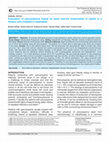Vol. 3, No. 4, 2018 by Shahzad Ali Baloch

Research Article, Dec 2018
Diabetes mellitus is a multi-factorial disease having widespread effect on various functions of b... more Diabetes mellitus is a multi-factorial disease having widespread effect on various functions of body. Electrolyte
imbalance is a major problem presenting in diabetic patients due to direct effect of hyperglycemia on these electrolytes.
Objective: The aim of this study is to evaluate the electrolyte imbalance in patients with diabetes mellitus type 2.
Methods: It is a prospective study, conducted at Department of Pathology, Indus Medical College. Tando Muhammad Khan between the
periods of January 2018 to March 2018. A total of 290 patients were included in this study. Group A contains 140 known diabetic patients and
Group B contains 150 normal healthy individuals. Blood samples of all patients were evaluated for HbA1c, serum sodium (Na), potassium (K)
and chloride (Cl).
Results: A total of 290 patients were included in the study. Male to female ratio was higher in both diabetic and control groups. Hemoglobin
A1C (HbA1c) was found to be higher in diabetic patients as compared to normal healthy individuals with statistically significant difference (p
< 0.001). Sodium (Na) was found to be low in diabetic group as compared to normal healthy individuals with statistically significant difference
(p = 0.02). Potassium (K) and chloride (Cl) did not show any difference in diabetic group and normal healthy individuals.
Conclusion: Diabetes mellitus has wide diversity of effects on major functions and cellular events. Electrolyte imbalance is a major problem
in diabetic patients as disturbs the distribution of cells across the cellular compartments
VOL. 4, NO. 3, 2019 by Shahzad Ali Baloch

Research Article, Sep 2019
Abstract: Introduction: Retinoblastoma is most common pediatric ocular malignancy. Majority of pa... more Abstract: Introduction: Retinoblastoma is most common pediatric ocular malignancy. Majority of patients presented with unilateral disease.
Infiltration to other organs is common with bone marrow being one of the most common organ involved.
Methodology: This study was conducted at Pakistan Institute of Medical Sciences Islamabad for a period of one year. A total of 47 known
patients of retinoblastoma were included in study. All patients underwent bone marrow biopsy for evaluation of infiltration.
Results: Out of 47 patients, 32 (68.1%) were male and 15 (31.9%) were female (ratio 2.13:1). 37 (78.7%) patients were unilateral and 10 (21.3%) were bilateral. Bone marrow infiltration was present in 14 (29.78%) cases.
Conclusion: Bone marrow is among most common sites of involvement in patients with bone marrow biopsy. Distant metastatic involvement has great impact on treatment and overall survival of patients.
VOL. 5, NO. 2, 2020 by Shahzad Ali Baloch
Case Report, Oct 21, 2020
Abstract: Chronic myeloid leukemia is a myeloproliferative neoplasm. It is a common disease of el... more Abstract: Chronic myeloid leukemia is a myeloproliferative neoplasm. It is a common disease of elderly, rarely affecting pediatric, adolescent or young adults. The median age of presentation is 65 years. The incidence is 1_2 cases per 100,000 adults. Tyrosine kinase inhibitors (TKIs) are highly successful and have good remission rates in the CML treatment; though multiple factors are associated with failure of treatment. We present a patient of 14 years old male who was diagnosed as CML. He was seven months into TKI therapy, transformed into B-Lineage acute lymphoblastic leukemia.
Case Report, Oct 21, 2020
Abstract: Acute Promyelocytic Leukemia (APL) is a very uncommon type of acute myeloid leukemiacom... more Abstract: Acute Promyelocytic Leukemia (APL) is a very uncommon type of acute myeloid leukemiacomprising less than 10% of pediatric population. Acute Promyelocytic leukemia is a neoplastic proliferation of abnormal promyelocytes in bone marrow, caused by cytogenetic abnormality t(15;17). Majority of patients (80%) have long term survival, and death occurs in approximately 10% of patients in early course of the disease; mainly because of hemorrhage. Hemorrhagic complications can be reduced by appropriate therapy if started timely, which ultimately reduces the risk of death.We report a case of 7 years old boy with complaints of fever off and on for past 06 months, bruises and swelling on left leg for 1 week, blood containing vomiting for 1day. He was diagnosed as APL on bone marrow biopsy.
Papers by Shahzad Ali Baloch

National journal of health sciences, May 18, 2020
Coronavirus 2019 (COVID-19), previously called as 2019-nCoV, was emerged from Wuhan, China in Dec... more Coronavirus 2019 (COVID-19), previously called as 2019-nCoV, was emerged from Wuhan, China in December 2019. It is caused by Severe Acute Respiratory Syndrome Coronavirus 2 (SARS-CoV-2). By 22 March 2020, 323,265 people were infected from this virus, including 13,745 deaths globally. It is declared as pandemic by World Health Organization as it involved 185 countries of the world. World Health Organization also declared it as 6th public health emergency of international concern. COVID-19 presents as various outcomes; asymptomatic (carrier), pneumonia and acute respiratory disease. People of all ages can be affected from this virus but adult population is observed to be involved in high ratio. Additionally, there is possibility that infection can be spread as nosocomial infection to patients and healthcare workers. On chest imaging, ground-glass opacity with bilateral involvement is seen as most common abnormality in patients with pneumonia. Older patients are prone to develop more severe disease as compared to young population. Patients with underlying chronic co-morbidities are also more prone to develop poor outcome. Till now, specific treatment of COVID-19 is not available; however clinical trials are under investigation to see the clinical efficacy of various therapeutic agents in China e.g. remdesivir and chloroquine etc. At this time, standard infection control measures are only possible means for prevention of SARS-CoV-2.
Drugs and cell therapies in hematology, Aug 2, 2021

The Professional Medical Journal
Objective: To evaluate etiological spectrum of pancytopenia in adults using bone marrow aspiratio... more Objective: To evaluate etiological spectrum of pancytopenia in adults using bone marrow aspiration biopsy. Study Design: Randomized Prospective study. Setting: Department of Pathology, Pakistan Institute of Medical Sciences, Islamabad. Period: October 2018-October 2020. Material & Methods: Eight hundred bone marrow biopsies were performed out of which 250 patients came with pancytopenia. 135 patients out of these were in adult age group which are included in this study. Results: Out of 250 patients adults were 135 that presented with pancytopenia. Male to female ratio came out to be 1.22:1. The most common disorder that results in pancytopenia came out to be megaloblastic anemia that was 29.6%, after that 26.6% were infection related changes, 10.3% aplasia, 9.6% reactive marrow, 5.9% acute leukemia, 3.7% chronic leukemia and iron deficiency anemia followed by 2.9% myelodysplastic syndromes and hypersplenism, 2.2% multiple myeloma, 1.4% mixed deficiency anemia and 0.74% myelofibrosis...
National Journal of Health Sciences
Diamond-Blackfan Anemia (DBA) DBA is commonest reason for isolated failure of production of red c... more Diamond-Blackfan Anemia (DBA) DBA is commonest reason for isolated failure of production of red cells. Most patients present clinically in 1st year of life in form of anemia dependent on transfusion. Though, patients may present in late years, as in non-classical DBA [4]. 7 per million births are affected by classical DBA. Congenital manifestations include short stature, dysmorphic faces, abnormalities of hand, kidney, and eye, in half of the patients [5]. This syndrome has tendency to transform into various malignancies i.e., acute myeloid leukemia, myelodysplastic syndrome, female genital malignancies, colon cancers and bone malignancies [6]. The incidence for development of

Journal of Pharmaceutical Negative Results
Aim: To determine the effect of lactose intolerance on serum glucose levels and related biochemic... more Aim: To determine the effect of lactose intolerance on serum glucose levels and related biochemical parameters in the adult population who refrain from consuming milk and milk products.Material and Method: This retrospective, observational study was conducted in a tertiary care hospital between January 2021 and December 2021 with 296 participants. Plasma glucose, calcium, 25-hydroxyvitamin D3, folate, vitamin B12, thyroid- stimulating hormone (TSH), and ferritin levels were controlled. Patients with positive lactose intolerance test results were accepted as the study group and negative results were accepted as the control group, and data of two groups were compared.Results: Of the total 296 participants 212 (71.7%) were found to have lactose intolerance and 84 (28.3%) were found to be normal. In the lactose intolerant group, blood glucose levels were significantly lower than the control group (5.14±0.53 mmol/L versus 5.47±0.54 mmol/L, p<0.001). In the lactose intolerant group, 29...
Drugs and cell therapies in hematology, Sep 1, 2021
LINGUISTICA ANTVERPIENSIA, May 22, 2021
Journal of critical reviews, 2021
Annals of King Edward Medical University Lahore Pakistan, 2020
National Journal of Health Sciences, 2021
Abstract: Sofosbuvir is an oral nucleoside analogue and potent inhibitor of the Hepatitis C virus... more Abstract: Sofosbuvir is an oral nucleoside analogue and potent inhibitor of the Hepatitis C virus (HCV) RNA polymerase that is used in combination with other antiviral agents to treat chronic Hepatitis C Nevertheless, and for unknown reasons, successful antiviral therapy of Hepatitis C with Sofosbuvir and other direct acting agents in patients with cirrhosis is occasionally complicated by hepatic decompensation. Here we describe 2 case report of upper gi bleed at initial days of treatment with Sofosbuvir and Ribavirin. Keywords: Variceal bleeding , Sofosdbuvir, Ribavirin, Heptitis C, Nucleoside analogue, Antiviral.
Hematology & Transfusion International Journal, 2018
Pancytopenia is very important clinical condition presenting to physicians. It presents as the ou... more Pancytopenia is very important clinical condition presenting to physicians. It presents as the outcome of various clinical conditions. Pancytopenia is the condition in which all three components of blood (e.g. red blood cells, white blood cells and platelets), are decreased.1 Initially, mild problems in bone marrow function may not be detected and usually presents during stress period or when demand is increased (e.g. bleeding or sepsis). Various conditions present as pancytopenia with underlying mechanisms being reduced production of hemopoietic cells, bone marrow growth reduction, suppression of cell differentiation, infiltration by abnormal cells, defect in the synthesis of cells which are eliminated from circulation.2

Background: To assess the attitudes and practices of parents of Beta-Thalassaemia Major children ... more Background: To assess the attitudes and practices of parents of Beta-Thalassaemia Major children regarding Chorionic Villous Sampling (CVS), as prenatal diagnosis in subsequent pregnancies. Methods: In this cross-sectional study a predesigned questionnaire was used to evaluate the socio-demographic profile and attitudes of parents of 210 registered thalassaemic children, regarding CVS.Only those parents who had one or more pregnancies after the index case were included in the study. Results were entered and analyzed on SPSS version 20. Results: After the index case, 36.2% parents underwent CVS in all subsequent pregnancies . The common reasons not to utilize this facility were lack of knowledge (47.7%), careless attitude (41.7%), family pressure (4.4%) and financial issues (1.5%). Religious reason was not found in any of the cases. Majority of the families (54.3%) belonged to lower middle class financial status. There was a significant association between CVS practice and educationa...











Uploads
Vol. 3, No. 4, 2018 by Shahzad Ali Baloch
imbalance is a major problem presenting in diabetic patients due to direct effect of hyperglycemia on these electrolytes.
Objective: The aim of this study is to evaluate the electrolyte imbalance in patients with diabetes mellitus type 2.
Methods: It is a prospective study, conducted at Department of Pathology, Indus Medical College. Tando Muhammad Khan between the
periods of January 2018 to March 2018. A total of 290 patients were included in this study. Group A contains 140 known diabetic patients and
Group B contains 150 normal healthy individuals. Blood samples of all patients were evaluated for HbA1c, serum sodium (Na), potassium (K)
and chloride (Cl).
Results: A total of 290 patients were included in the study. Male to female ratio was higher in both diabetic and control groups. Hemoglobin
A1C (HbA1c) was found to be higher in diabetic patients as compared to normal healthy individuals with statistically significant difference (p
< 0.001). Sodium (Na) was found to be low in diabetic group as compared to normal healthy individuals with statistically significant difference
(p = 0.02). Potassium (K) and chloride (Cl) did not show any difference in diabetic group and normal healthy individuals.
Conclusion: Diabetes mellitus has wide diversity of effects on major functions and cellular events. Electrolyte imbalance is a major problem
in diabetic patients as disturbs the distribution of cells across the cellular compartments
VOL. 4, NO. 3, 2019 by Shahzad Ali Baloch
Infiltration to other organs is common with bone marrow being one of the most common organ involved.
Methodology: This study was conducted at Pakistan Institute of Medical Sciences Islamabad for a period of one year. A total of 47 known
patients of retinoblastoma were included in study. All patients underwent bone marrow biopsy for evaluation of infiltration.
Results: Out of 47 patients, 32 (68.1%) were male and 15 (31.9%) were female (ratio 2.13:1). 37 (78.7%) patients were unilateral and 10 (21.3%) were bilateral. Bone marrow infiltration was present in 14 (29.78%) cases.
Conclusion: Bone marrow is among most common sites of involvement in patients with bone marrow biopsy. Distant metastatic involvement has great impact on treatment and overall survival of patients.
VOL. 5, NO. 2, 2020 by Shahzad Ali Baloch
Papers by Shahzad Ali Baloch
imbalance is a major problem presenting in diabetic patients due to direct effect of hyperglycemia on these electrolytes.
Objective: The aim of this study is to evaluate the electrolyte imbalance in patients with diabetes mellitus type 2.
Methods: It is a prospective study, conducted at Department of Pathology, Indus Medical College. Tando Muhammad Khan between the
periods of January 2018 to March 2018. A total of 290 patients were included in this study. Group A contains 140 known diabetic patients and
Group B contains 150 normal healthy individuals. Blood samples of all patients were evaluated for HbA1c, serum sodium (Na), potassium (K)
and chloride (Cl).
Results: A total of 290 patients were included in the study. Male to female ratio was higher in both diabetic and control groups. Hemoglobin
A1C (HbA1c) was found to be higher in diabetic patients as compared to normal healthy individuals with statistically significant difference (p
< 0.001). Sodium (Na) was found to be low in diabetic group as compared to normal healthy individuals with statistically significant difference
(p = 0.02). Potassium (K) and chloride (Cl) did not show any difference in diabetic group and normal healthy individuals.
Conclusion: Diabetes mellitus has wide diversity of effects on major functions and cellular events. Electrolyte imbalance is a major problem
in diabetic patients as disturbs the distribution of cells across the cellular compartments
Infiltration to other organs is common with bone marrow being one of the most common organ involved.
Methodology: This study was conducted at Pakistan Institute of Medical Sciences Islamabad for a period of one year. A total of 47 known
patients of retinoblastoma were included in study. All patients underwent bone marrow biopsy for evaluation of infiltration.
Results: Out of 47 patients, 32 (68.1%) were male and 15 (31.9%) were female (ratio 2.13:1). 37 (78.7%) patients were unilateral and 10 (21.3%) were bilateral. Bone marrow infiltration was present in 14 (29.78%) cases.
Conclusion: Bone marrow is among most common sites of involvement in patients with bone marrow biopsy. Distant metastatic involvement has great impact on treatment and overall survival of patients.